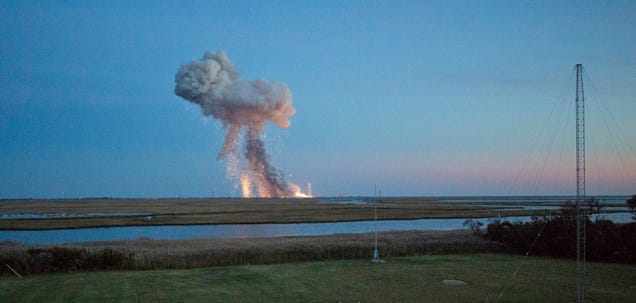
When the Antares rocket exploded seconds after launch on Tuesday night, NASA was able to account for all its employees very quickly after the failure thanks to a clearly very well-practiced protocol. The launch gave us a peek into the processes that dictate every rocket launch, and one of them was particularly surprising.
In the press conference following the explosion, we learned that as Antares began behaving "erratically" a few seconds after liftoff, the launch crew responsible for tracking it initiated something called the flight termination system—which essentially pulls the plug on a rocket launch before it can climb too high and cause potential damage as it malfunctions. But who makes that decision, and with what split-second information?
In a fascinating story in National Geographic today entitled Why NASA Blew Up a Rocket Just After Launch , Brad Scriber explains. According to Scriber—who watched the Antares failure in person on Wallops Island—two employees at every launch play an important and dangerous role at every launch. Rather than staying protected with the rest of the team, these employees watch the launch's first few seconds from behind carefully positioned wood and wire frames.
Why? Because at this point, radar is too imprecise to track the rocket's position—and human sight is more reliable. Scriber writes:
In the early seconds of a launch, when the rocket is near the ground, there is too much interference from trees and nearby structures for radar and other monitoring systems to be accurate. So spotters watch the launch through wooden viewing frames fitted with guide wires. If the rocket crosses behind a wire, they know it's veering off track and they send up an alarm telling the safety officers to abort. Then they seek shelter.
According to a 2008 Popular Mechanics story about these Range Safety employees, they're responsible for manning the Launch Termination call for the first full two minutes of flight. "If something happens when it's just off the pad, there's only a couple of seconds [to react]," a former NASA shuttle commander told the magazine.
It's fascinating to know that plain sight plays such a huge role one of humanity's most complex and sophisticated technological achievements. After all, human errors have been responsible for at least one massive rocket launch screw up, known as the Most Expensive Hyphen in History, when a single errant hyphen in a launch code caused a $60 million rocket to explode in 1962. But it seems that in the end, we still have to trust our own eyes. [National Geographic]
Lead image: AP Photo/NASA, Joel Kowsky
from Gizmodo http://gizmodo.com/the-surprisingly-low-tech-way-nasa-decides-when-to-blow-1652978188
No comments:
Post a Comment